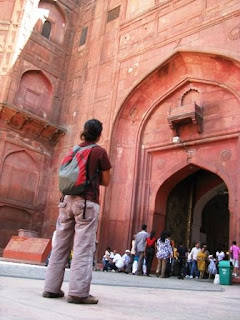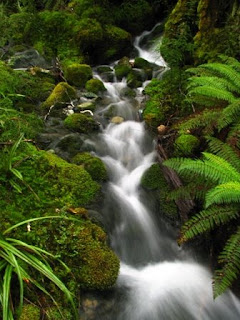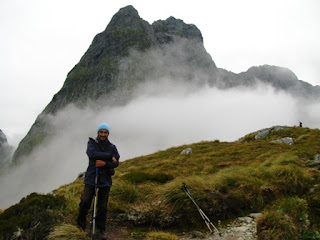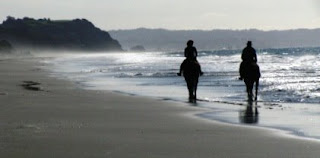Two things have impressed us so far: the elegance and bright colours of female attire, which is worn even when carrying a sack of stones at a construction site (here women work as much as men!), and the wide availability of books, not just fiction but even heavy philosophical texts, by the side of the road. And we cannot forget to mention the entrepreneurship of some people we encountered– one old man made his living by cleaning the ears of passers-by! He even had a Maltese customer once and showed us his recommendation in Maltese!

Mcleod Ganj
 Red Fort, Delhi
Red Fort, Delhi

 Delhi Train Station
Delhi Train Station

----------------------------------------
Mcleod Ganj, Upper Dharamsala, our home for the next few months. Few people knew about this little town perched on a ridge between the Kangra and Chamba valleys , until H.H. The Dalai Lama and other Tibetan exiles settled here in 1959.
Reaching this lovely village involved a 10 hour train journey and a 4 hour bus ride to the foothills of the Dhauladhar Range, south of the Himalayas. We are now living in a small room at a Buddhist monastery, which apart from offering a splendid view of the Kangra Valley and the Dhauladhars, allows us to become part of the daily rhythm of the monastery – breakfast bell at 6 am, chanting at 6.30 am, morning recitations, tea at 3.00 pm, debating at 7.00 pm, etc/
To say the truth, coming to Dharamsala was our plan B. Initially we wanted to go to Tibet, but due to political problems that have intensified since the last Olympic games, we had to settle for this tiny village in the north of India. We are not at all sorry to have done so, however, because we are living and working with Tibetan people most of the time, and our room is just opposite the temple and residence of H.H. The Dalai Lama. We have to say that all of this would not have been possible without the kind help of Sister Tenzin, who was our initial contact here.
Nowadays our daily schedule is as follows:
06.30 am - Kora
08.00 am – Teaching English
11.00 am – Buddhist philosophy lesson at the library
1.00 pm – Teaching computing
3.00 pm – Teaching English
4.00 pm – Conversation skills with ex-political prisoners
Our diet consists mainly of Tibetan food, such as momos, thukpa and thentuk, although the odd Indian or Chinese dish does make its way into our menu. We are soon going to start having lunch and dinner with Buddhist nuns at a neighbouring nunnery.
 A woman weaving a Tibetan carpet.
A woman weaving a Tibetan carpet. Our room at the Monastery....
Our room at the Monastery.... ....and the view from our room.
....and the view from our room.

Monk playing a Tibetan game aimed at improving the mind.
 Tibetan orphan at Tibetan Children Village, a project initiated by H.H. The Dalai Lama to take care of refugees' children and orphans that come from Tibet.
Tibetan orphan at Tibetan Children Village, a project initiated by H.H. The Dalai Lama to take care of refugees' children and orphans that come from Tibet.Our classroom at the Library where everyday a geshe teaches us Buddhist philosophy.
 A musician playing traditional Tibetan music, a commendable effort to keep Tibetan culture alive.
A musician playing traditional Tibetan music, a commendable effort to keep Tibetan culture alive. Tibetan prayer flags, a legacy of the Bon religion that predates Buddhism in Tibet and the Himalayas.
Tibetan prayer flags, a legacy of the Bon religion that predates Buddhism in Tibet and the Himalayas. Buddhist nunnery just outside of Dharamsala.
Buddhist nunnery just outside of Dharamsala.


The Kora
After waking up at 6.30 am we join many Tibetans on their clockwise walk around the temple and residence of H.H. The Dalai Lama. We walk past many engraved stone mantras, prayer flags, until we arrive at the main site. There we turn prayer wheels and listen to monks chanting while we are served with rice and butter tea. We then walk back to the main entrance as the sun is rising. It is so beautiful to join the Tibetans in this daily ritual, which they used to perform at Potala palace in Lhasa, Tibet.
 Slates engraved and painted with the 'Om mani padme hum' mantra.
Slates engraved and painted with the 'Om mani padme hum' mantra.
The prayer wheel holds numerous copies of the above mantra inside. Turning the wheel is equivalent to reciting the mantra.


 When all the prayers are said, the Tibetans stand one next to the other, sing the beautiful Tibetan national anthem, and throw tsampa (barley flour) into the air. We have not yet managed to come out from the kora not covered in flour!
When all the prayers are said, the Tibetans stand one next to the other, sing the beautiful Tibetan national anthem, and throw tsampa (barley flour) into the air. We have not yet managed to come out from the kora not covered in flour!

 The boy in the photo is the Panchen Lama, the youngest political prisoner in the world. We attended the ceremony at the main temple to celebrate his 20th birthday. In 1995, H.H. The Dalai Lama identified this boy as the re-incarnation of the 10th Panchen Lama. Three days later China arrested the boy and his whole family, and since then no news have been heard about them – we do not know where they are, whether they are dead or alive. China also put their own 'dummy' Panchen Lama in his place, which is foolish because the Panchem Lama, unlike the Dalai Lama, holds no political power in Tibet. This is just one of the many horrific atrocities being committed by the Chinese in Tibet.
The boy in the photo is the Panchen Lama, the youngest political prisoner in the world. We attended the ceremony at the main temple to celebrate his 20th birthday. In 1995, H.H. The Dalai Lama identified this boy as the re-incarnation of the 10th Panchen Lama. Three days later China arrested the boy and his whole family, and since then no news have been heard about them – we do not know where they are, whether they are dead or alive. China also put their own 'dummy' Panchen Lama in his place, which is foolish because the Panchem Lama, unlike the Dalai Lama, holds no political power in Tibet. This is just one of the many horrific atrocities being committed by the Chinese in Tibet.












































